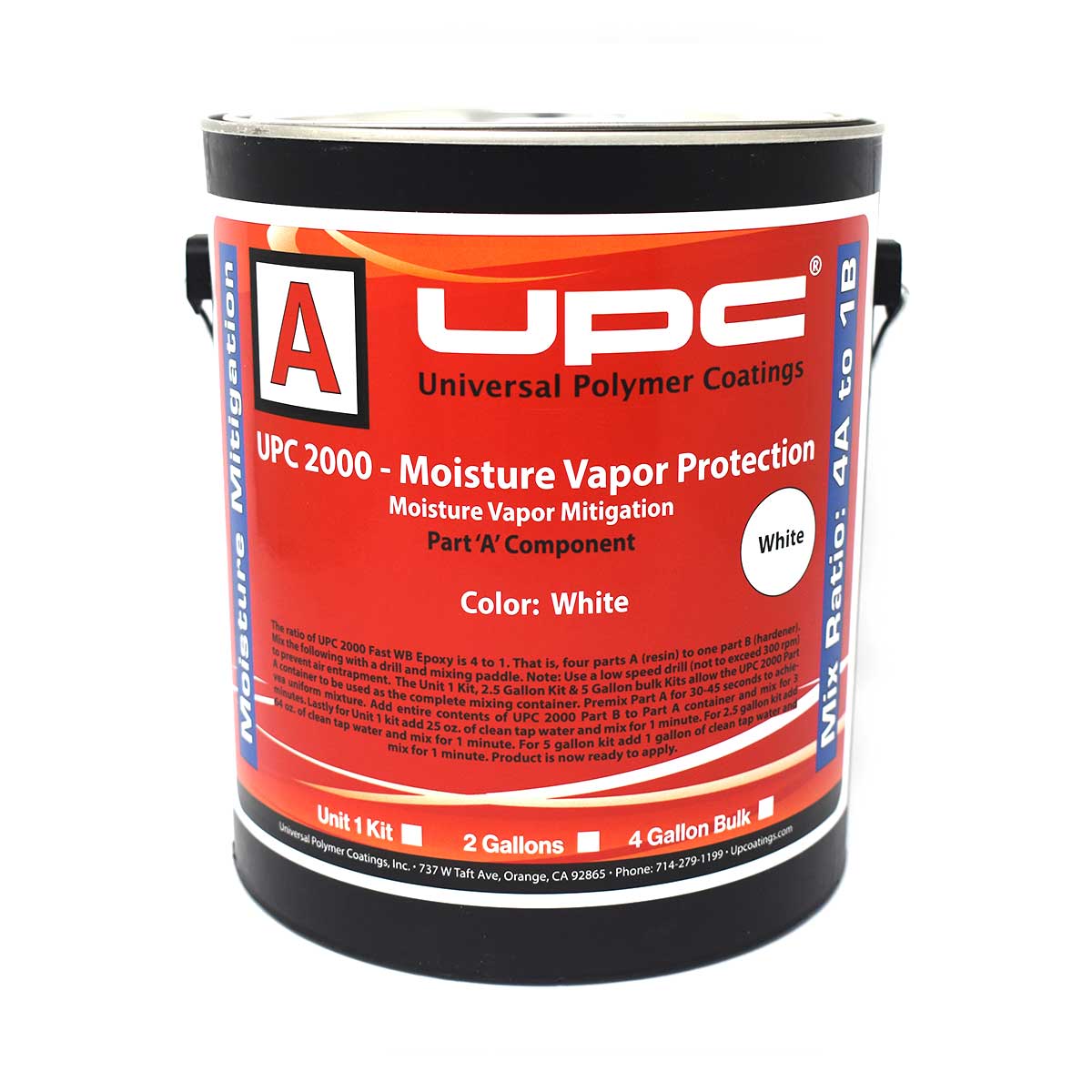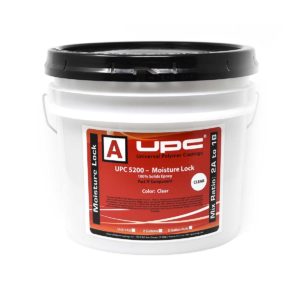UPC 2000 Moisture Vapor Protection
UPC 2000 Moisture Vapor Protection is a two-component, water reducible polymer, formulated to reduce water vapor transmission levels of up to 30 lbs/1,000 SF in 24 hours to meet manufacturer’s acceptable levels. The low viscosity polymer penetrates and mechanically bonds deep into properly prepared concrete. UPC 2000 is alkali resistant and will not support biological growth (bacteria, fungus, mold or algae). The material is generally applied in two or more thin coats providing a durable, breathable coating that reduces moisture vapor. In some cases, a self-leveling, self-drying cement is installed over the vapor system to provide a smooth and level substrate.
Download TDS:
Advantages
- Low odor
- Self-priming
- Easy to apply, long pot life
- VOC compliant
- Does not support biological growth
- Can be applied over damp/10 day old concrete
- Easy to clean up with soap and water
- Alkali resistant to pH 14
Flooring Compatibility
UPC 2000 is compatible with the following flooring materials:
- Wood
- VCT
- Linoleum
- Ceramic Tile
- Carpet
- Carpet Tile
- Rubber
- Polymer Coatings
- Most Flooring Mortar and Mastics
Colors
UPC 2000 is available in white and medium grey.
Packaging
UPC 2000 is available in two kit sizes:
| Part A | Part B | |
| 1.25 Gallon Kit | 1 gal. | .25 gal. |
| 5 Gallon Kit | 4 gal. | 1 gal. |
Physical Properties
| PROPERTY | VALUE | REFERENCE |
| Bond to Concrete | 350 psi | ASTM D 4541 |
| Concrete fails at this point | ||
| Taber Abrasion | 70-75 Mgs | ASTM D 4060 |
| CS 17 Wheels | ||
| Flammability | Self-extinguishing | |
| Pencil Hardness | 2 H | |
| Flash Point | >200°F | |
Product Data
| Volumetric Ratio: | 4 to 1 |
| Solids: | 50% (+ or – 1%) |
| Coverage: | 300-400 SF/gal./coat |
| 150-200 SF/gal. (4-5 mil, 2 coats) | |
| Application temperature: | 55-90°F |
| Thinning: | May add up to 20% water |
| Pot life: | 1-2 hours at 75°F |
| Working time on floor: | 15-30 minutes |
| Cure time: | 12-16 hours (walking) |
| 24 hours (traffic) | |
| Critical recoat time: | 24 hours |
| Shelf life: | 12 months |
Concrete Preparation
Before coating is applied, concrete must be:
- Dry – No wet areas
- Clean – Contaminants removed
- Profiled – Surface etched
- Sound – All cracks and spalled areas repaired
Mechanical preparation is the preferred method of preparing concrete for coating application. Shot-blasting, diamond grinding, scarifying and scabbling are all acceptable methods.
Patching
Patch after prep and application of UPC 2000. Voids, cracks, and imperfections will be seen in finished coating if the concrete is not patched correctly. Patch concrete with UPC Perfect Patch. After the patching material is cured, diamond grind patch. If a non-UPC patching material is used, contact a UPC technical representative for a compatible and approved alternative.
Testing
All surfaces are not the same. It is recommended that a sample area be done before the start of the project. The test should be done on-site, using the proposed method by the assigned applicator to ensure proper adhesion and color. A sample area should also be done on any existing coatings to determine if any contaminants exist or if delaminating will occur.
Mixing
The ratio of UPC 2000 is 4 to 1. That is, four parts A (resin) to one part B (hardener). Due to the coating’s extended pot life, multiple 5-gallon kits may be mixed at one time for application. Mix the following with a drill and mixing paddle. Note: If using a drill mixer, use a low speed (not to exceed 300 rpm) to prevent air entrapment.
- Pre-mix Part A until uniform. Part B does not require pre-mixing. If using the 5-gallon kit, pour all of part B into the 6-gallon bucket of Part A.
- Mix the combined material for 2-3 minutes.
- Allow to acclimate for 20 minutes. Add one gallon of clean tap water to the mixed material and mix again for 1-2 minutes. The material is now ready to apply. UPC 2000 has a pot life of 1-2 hours. Once poured out on the floor, 15-30 minutes of working time can generally be expected.
Application Instructions
UPC 2000 is applied in two coats. For estimating purposes, use 200 SF (4 mil) to 150 SF (5 mil) as a coverage rate. The following is for a two coat system:
- Always apply in descending temperatures. Concrete is porous and traps air. In ascending temperatures (generally mornings), the air expands and can cause outgassing in the coating. It is safer to apply coatings in the late afternoon, especially for exterior applications.
- Optimum ambient temperature should be between
- 55-90°F and at least 5° above the dew point during application.
- Mix 5 gallons of coating using above mixing instructions.
- Apply approximately 300 SF/gallon by immediately pouring out on surface in a ribbon or small puddles. Spread by using a squeegee on a pole, pulling UPC 2000 over substrate.
- Using a 3/8” non-shedding paint roller, roll coating forward and backward. Do not allow puddles in low spots, cracks, and divots. Brush out excess material.
- Backroll in the opposite direction as noted in Step 6. Pull resin fairly thin while completely wetting out concrete and uniformly covering the surface. Keep a wet edge and as soon as the coating is uniform on the floor leave it alone. Do not go back to touch up.
- After the first coat is cured enough to walk on (4-24 hours), apply second coat by repeating steps 1-5. The coverage will be higher as the first coat primarily seals out most of the concrete.
Clean-up
UPC 2000, while in a un-reacted state, may be cleaned up with soap and water. Isopropyl alcohol or acetone may be needed once the resin begins hardening.
Product Limitations
- Interior use only
- UPC 2000 is not a waterproofing membrane and is not intended to stop liquid water intrusion through or into the slab.
- Not for use over any other substrates other than concrete slabs cured for a minimum of 10 days at 70°F
UPC 2000 MVP can be applied to green concrete that has had at least 10 days to cure. The surface to be coated with UPC 2000 MVP must be free of moisture-sensitive patching and leveling materials, adhesives, coatings, curing compounds, concrete sealers, efflorescence, dust, grease, oils and any other materials or contaminants that can act as bond breakers.
Coating systems are susceptible to cracking if the concrete moves or separates below the coating. Hence, joint and crack treatment should be reviewed prior to coating application. As a general rule, control joints and random cracks should be saw cut or chased first, then filled with UPC Perfect Patch. Cold joints (two slabs which meet and hence move) should be treated. After the coating has been applied and cured, saw cut through the coating over construction joints and apply elastomeric caulking.
Coating systems are susceptible to cracking if the concrete moves or separates below the coating. Hence, joint and crack treatment should be reviewed prior to coating application. As a general rule, control joints (saw cuts) and random cracks should be saw cut or chased first then filled with Perfect Patch or similar approved hard epoxy product. Construction joints (two slabs that meet and hence move) should be treated. After the coating has been applied and cured, saw cut through the coating over construction joints and apply elastomeric caulking.
Warranty
Universal Polymer Coatings products are warranted for one year after date of purchase. Please refer to the UPC Limited Material warranty for additional clarification. UPC 2000 Moisture Vapor Protection can also come with an additional warranty per job. Please contact UPC Representative for additional information and how to obtain additional warranty coverage.
Safety
Consult UPC 2000 safety data sheet. Avoid UPC 2000 contact with skin. Some individuals may be allergic to this coating. Protective gloves and clothing are recommended.




